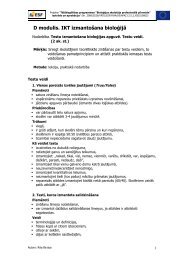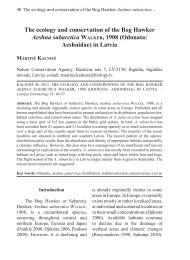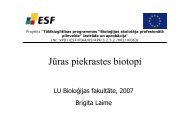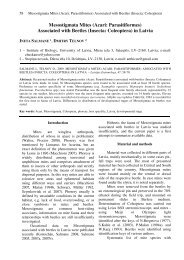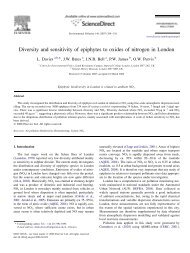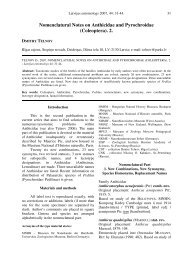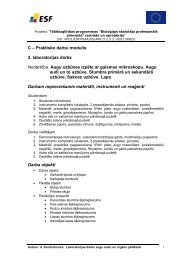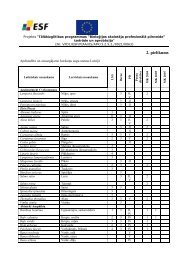Dissolved organic matter in water of Daugava river
Dissolved organic matter in water of Daugava river
Dissolved organic matter in water of Daugava river
You also want an ePaper? Increase the reach of your titles
YUMPU automatically turns print PDFs into web optimized ePapers that Google loves.
Monitor<strong>in</strong>g <strong>of</strong> Free Radical Processes <strong>in</strong> Prote<strong>in</strong>-lipid Systems with a NewSquara<strong>in</strong>e DyeO.Kutsenko *1 , V.Trusova 1 , G.Gorbenko 1 , T.Deligeorgiev 2 , E.Slobozhan<strong>in</strong>a 3 , L.Lukyanenko 3 ,G.Zubritskaya 31 V.N. Karaz<strong>in</strong> Kharkov National University, Kharkov, Ukra<strong>in</strong>e;2 Faculty <strong>of</strong> Pharmacy and Chemistry, University <strong>of</strong> S<strong>of</strong>ia, S<strong>of</strong>ia, Bulgaria;3 Institute <strong>of</strong> Biophysics and Cell Eng<strong>in</strong>eer<strong>in</strong>g, National Academy <strong>of</strong> Sciences <strong>of</strong> Belarus,M<strong>in</strong>sk, Belaruse-mail: olzk@mail.ruAmyloids are highly ordered prote<strong>in</strong> aggregates whose deposition <strong>in</strong> organs and tissues is one<strong>of</strong> the characteristics <strong>of</strong> so called prote<strong>in</strong> misfold<strong>in</strong>g diseases. These disorders <strong>in</strong>cludePark<strong>in</strong>son, Alzheimer, Hunt<strong>in</strong>gton, prion diseases, etc. It was demonstrated that one <strong>of</strong> thereasons <strong>of</strong> amyloid cytotoxicity <strong>in</strong>volves <strong>in</strong>teraction <strong>of</strong> aggregated prote<strong>in</strong>s with cellmembranes, particularly with red blood cell membrane. The mechanisms <strong>of</strong> erythrocyte <strong>in</strong>jury<strong>in</strong>clude modification <strong>of</strong> membrane fluidity, alterations <strong>in</strong> enzyme activity and oxidation state,apoptosis and oxidative stress.The present study was undertaken to explore amyloid effect on membrane lipid oxidation. Tothis end, we used model systems conta<strong>in</strong><strong>in</strong>g lysozyme amyloid fibrils (Lz), hemoglob<strong>in</strong> (Hb)and liposomes from phosphatidylchol<strong>in</strong>e (PC) and its mixtures with cardiolip<strong>in</strong> (CL) andcholesterol (Chol). For identification <strong>of</strong> the presence <strong>of</strong> active oxygen species novel squara<strong>in</strong>edye SQ-1 was applied [1]. It has been previously found that Hb-<strong>in</strong>duced formation <strong>of</strong> freeradicals leads to the drastic quench<strong>in</strong>g <strong>of</strong> SQ-1 fluorescence, result<strong>in</strong>g presumably from thereaction between reactive oxygen species and SQ-1 squaric moiety [2]. Lz association withlipid bilayers was not followed by SQ-1 spectral changes <strong>in</strong>dicat<strong>in</strong>g <strong>in</strong>sensibility <strong>of</strong> this probeto Lz-<strong>in</strong>duced membrane modification. Hb addition to liposomes without Lz was followed bysignificant decrease <strong>of</strong> SQ-1 emission <strong>in</strong>dicat<strong>in</strong>g the formation <strong>of</strong> free radicals. SQ-1fluorescence quench<strong>in</strong>g was found to depend on model membrane composition. In PC andPC/Chol bilayers the decrease <strong>of</strong> SQ-1 fluorescence was less pronounced than <strong>in</strong> CLconta<strong>in</strong><strong>in</strong>gmembranes. Interaction <strong>of</strong> the Hb with negatively charged membranes can befollowed by prote<strong>in</strong> unfold<strong>in</strong>g, heme displacement and dissociation <strong>of</strong> heme-glob<strong>in</strong> complex.This facilitates heme-lipid <strong>in</strong>teraction and consequent iron-<strong>in</strong>duced formation <strong>of</strong> free radicalslead<strong>in</strong>g to the <strong>in</strong>crease <strong>of</strong> free radical formation <strong>in</strong> CL bilayers as compared to PCmembranes. Cholesterol prevents Hb penetration <strong>in</strong>to the <strong>in</strong>ner membrane regions, thus<strong>in</strong>hibit<strong>in</strong>g oxidative processes. Interest<strong>in</strong>gly, lysozyme fibrils suppressed SQ-1 fluorescencequench<strong>in</strong>g <strong>in</strong> all types <strong>of</strong> lipid bilayers, with the magnitude <strong>of</strong> this effect be<strong>in</strong>g mostpronounced <strong>in</strong> CL-conta<strong>in</strong><strong>in</strong>g membranes. There are at least two explanations for Lzantioxidant effect. First, prote<strong>in</strong> molecular groups can be the scavengers for free radicals. Onthe other hand, Hb and Lz can compete for the membrane b<strong>in</strong>d<strong>in</strong>g sites, thereby reduc<strong>in</strong>g Hbpenetration <strong>in</strong>to the membrane <strong>in</strong>terior and formation <strong>of</strong> free radicals.This work was supported by the grant from Fundamental Research State Fund <strong>of</strong> Ukra<strong>in</strong>e(project number F41.1/014) and Fundamental Research State Fund <strong>of</strong> Belarus Republic(project number B11K-152).1. I<strong>of</strong>fe, V.M., Gorbenko, G.P., Deligeorgiev, T., Gadjev, N., Vasilev, A. Fluorescence study <strong>of</strong>prote<strong>in</strong>-lipid complexes with a new symmetric squarylium probe. Biophys. Chem., 2007, vol. 128, p.75–86.2. Trusova, V.M., Gorbenko, G.P., Deligeorgiev, T., Gadjev, N., Vasilev, A. A Novel Squarylium Dyefor Monitor<strong>in</strong>g Oxidative Processes <strong>in</strong> Lipid Membranes. J. Fluoresc., 2009, vol. 19, p. 1017–1023.- 26 -



